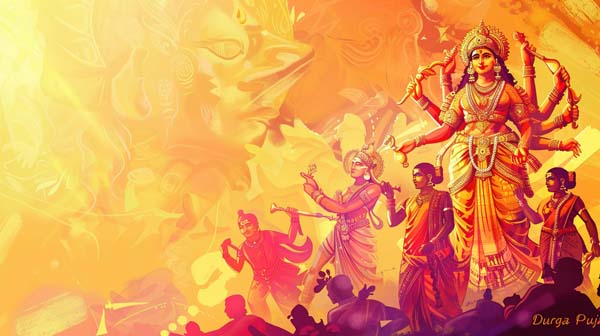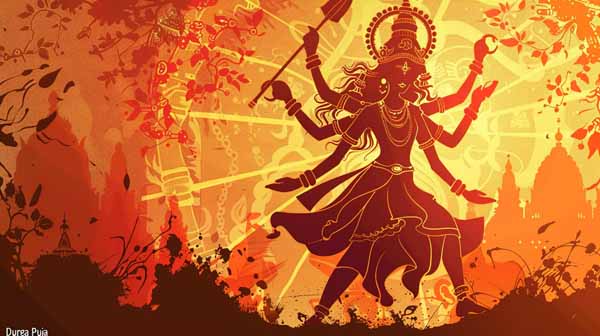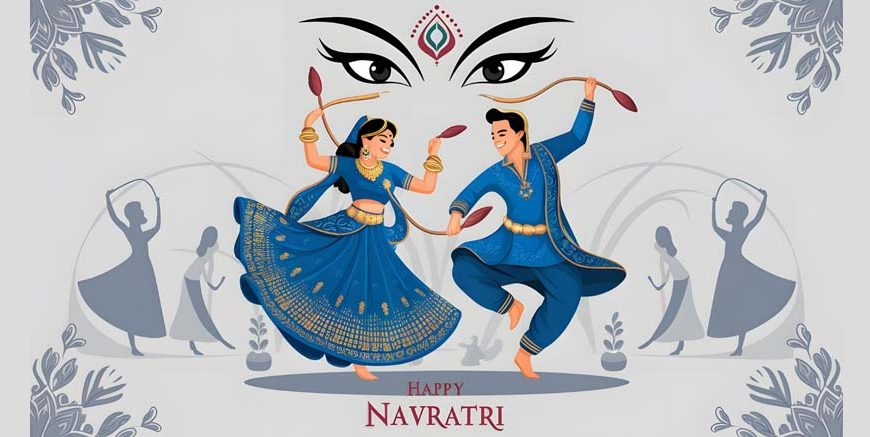The nine days of Navratri symbolise the victory of good over evil and the worship of the divine feminine energy that extends throughout the universe. Devotees gather during this festival to carry out numerous rituals, dance the exhilarating Garba, and seek the blessings of all the avatars of Goddess Durga. This year the divine feminine will be honoured for nine days beginning on October 15 and concluding on October 24 with the celebration of Vijaya Dasami.
India celebrates Navratri in a variety of ways depending on where it is observed. It honours the goddess Chamunda or Mahakali in some areas while the goddess Amba is honoured in others. The customs and traditions associated with Navratri can differ broadly, reflecting the rich cultural diversity of India.
Short Summary of the 9 Days of Navratri Festival
The word Navratri is derived from Sanskrit, with ‘Nav’ meaning nine and ‘Ratri’ meaning night. This 9 day festival in India is devoted to the divine feminine in her nine forms. Each day is dedicated to a different manifestation of Goddess Durga, symbolising qualities such as strength, wisdom, courage, and purity. The Navratri 9 days begin with prayers to Goddess Shailputri and end with worshipping Goddess Siddhidatri, who blesses her devotees with knowledge and fulfilment. Together, the nine days of Navratri narrate the story of resilience, reminding us why Navratri is celebrated for 9 days with such devotion across India.
Also Read: Navratri Fasting Guidelines, Benefits, and Recipe Ideas
Why Navratri is Celebrated for 9 Days

Many parents and children wonder why Navratri is celebrated for 9 days instead of a shorter period. The answer lies in its deep spiritual symbolism. Each day represents one form of Goddess Durga, showing how different qualities are necessary to overcome challenges in life. From patience and learning on the first day to courage and wisdom on the last, the nine days of Navratri teach us that strength is not only physical but also emotional and moral. For children, this lesson becomes a beautiful way of understanding virtues such as kindness, bravery, and resilience.
Navratri as a Cultural Classroom for Children
At EuroKids, festivals are more than just celebrations; they are opportunities for young learners to connect with their heritage. Navratri becomes a cultural classroom where children explore stories of Goddess Durga through role play, music, and creative arts. They paint diyas, make colourful garlands, and even dance to Garba rhythms, learning how traditions bring joy and meaning to life. By experiencing the 9 days of Navratri, children gain not only knowledge of history but also values of togetherness, respect, and gratitude.
Regional Flavours of Navratri in India
The 9 day festival in India is celebrated differently in each region, offering children a glimpse into the country’s cultural diversity. In Gujarat, Navratri nights come alive with Garba and Dandiya, while in West Bengal, the days are filled with grand Durga Puja pandals. In Tamil Nadu, families arrange Kolu, a beautiful display of dolls, while in Punjab, devotees participate in fasting and prayers. These traditions reflect how one festival can carry so many shades of meaning, helping young learners at EuroKids appreciate diversity and unity in the same breath.
Also Read: Transform Your Home into a Festive Wonderland with Navratri Decoration Ideas
The Spiritual Significance of Navratri 9 Days

For many families, the 9 days of Navratri are not just about rituals but also inner reflection. Fasting, meditation, and prayers encourage self-discipline and mindfulness. For children, this becomes an early introduction to the importance of balance and peace. Parents often narrate stories of Goddess Durga’s courage in defeating the demon Mahishasura, reinforcing the eternal message that goodness always prevails. The nine days of Navratri thus act as a reminder that challenges in life can be faced with courage, faith, and compassion.
Navratri 2025 – Dates and Celebrations
In 2025, Navratri will be celebrated from Monday, 22 September to Thursday, 2 October. Each of the nine nights will be devoted to a different form of the Goddess, beginning with Shailputri and ending with Siddhidatri. On the final day, Vijaya Dasami will be observed, symbolising victory and renewal. Families will gather for prayers, cultural activities will fill schools and communities, and the spirit of the nine days of Navratri will once again bring people together across India.
Also Read: Fun Activities to Celebrate Dussehra with Kids
History of the 9 Days of Navratri Festival
The “Nav” means “nine” and “Ratri” means “night.” As a result, the event got its name from the fact that we enjoyed it for nine nights. Here is a detailed explanation of all the nine forms of Goddess Durga which are worshipped during the Navratri Festival.
Day 1: Pratipada: Goddess Shailputri
The first day of Navratri is dedicated to Goddess Shailaputri, who is regarded as the symbol of the mountains. She is shown riding on a bull and is identified as the consort of Lord Shiva and the daughter of King Daksha.
Day 2: Dwitiya: Goddess Brahmacharini
Goddess Brahmacharini is worshipped on the second day. She stands for the pursuit of education and is pictured holding a water jug and a rudraksha mala (Kamandalu).
Day 3 – Tritiya: Goddess Chandraghanta
On the third day, Goddess Chandraghanta, the third form of Durga, is worshipped. She was given her name after the bell with a half-moon shape that she wore on her forehead.
Day 4 – Chaturthi: Goddess Kushmanda
The universe is thought to have been created by Goddess Kushmanda, who is honoured on the fourth day of Navratri.
Day 5 – Panchami: Skandamata
On this day, people worship Goddess Skandamata, the fifth manifestation of Durga. Her son, Lord Kartikeya, is shown resting on her lap. She is prayed by her followers for the security of their children and well-being.
Day 6 – Shashthi: Goddess Katyayani
On the sixth day, Goddess Katyayani, the sixth incarnation of Durga, is honoured. She is an image of boldness and is believed to have been born to Sage Katyayan.
Day 7 – Saptami: Goddess Kaalratri
On the seventh day, Goddess Kaalratri is the robust manifestation of drugs. Devotees pray to her for protection from negative energies.
Day 8 – Ashtami: Goddess Mahagauri
Navratri’s eighth day is devoted to the goddess Mahagauri, who is thought to have a bright, snow-white complexion.
Day 9 – Navami: Goddess Siddhidatri
Goddess Siddhidatri is honoured on the ninth and last day of Navratri. She is thought to have the ability to grant desires and assistance.
Significance of the 9 Days Of Navratri Festival
- Nine Nights of Celebration: Navratri lasts nine nights and ten days, symbolising the nine forms of Goddess Durga.
- Cultural Diversity: Navratri is observed across India with regional variations, highlighting the cultural diversity of the country.
- Seasonal Transition: Navratri signifies the change from the monsoon to the autumnal season, which is frequently connected to the harvest and agricultural rituals.
- The Victory of Good over Evil: It honours the victory of Durga over the demon Mahishasura, symbolising the victory of good over evil.
- Social Gathering: During Navratri, families and communities meet together for prayers, rituals, and joyous meals.
- Cultural Celebration: Besides its religious aspects, Navratri is a vibrant social festival, marked with music, dance, and colourful attire.
- Religious Importance: Devotees fast, pray, and perform rituals during Navratri for strength, knowledge, and protection.
Conclusion
During the festival of Navratri, devotees joyfully adore Goddess Durga. The nine days of Navratri provide plenty of time for families to get together, relax and rejoice. In this regard, the well-known play school EuroKids is playing an essential role in maintaining and teaching these cultural traditions to the younger generation. Along with offering holistic education, EuroKids includes cultural celebrations like Navratri in its curriculum. Here children learn about the rich history and importance of Navratri in a delightful and informative manner via storytelling, arts, and crafts. You can refer to EuroKids Blogs for more such content.
Frequently Asked Questions (FAQs)
1. What is the importance of the nine days of Navratri?
Navratri is celebrated to worship Goddess Durga in her nine forms, reminding us of the triumph of good over evil.
2. What are the names of the 9 Days of Navratri 2025?
The nine days of Navratri 2025 are Pratipada, Dwitiya, Tritiya, Chaturthi, Panchami, Shashthi, Saptami, Ashtami, and Navami.
3. When will Navratri be celebrated in the year 2025?
Navratri in 2025 will begin on Monday, 22 September and conclude on Thursday, 2 October with Vijaya Dasami.
4. What are Garba and Dandiya dances?
Garba is a traditional Gujarati dance performed in a circular pattern, while Dandiya Raas is a lively partner dance using decorated sticks. Both are central to Navratri celebrations.
5. Why is Navratri celebrated for 9 days?
Navratri lasts for nine days because each day is dedicated to one form of Goddess Durga. Together, the nine forms symbolise the different virtues needed to overcome challenges in life.
6. How is Navratri celebrated in different parts of India?
In Gujarat, people celebrate with Garba and Dandiya; in West Bengal, Durga Puja pandals are set up; in Tamil Nadu, Kolu doll displays are created; and in Punjab, devotees focus on fasting and prayers. Each region’s tradition adds colour to the festival.
Related Blogs:
- Durga Puja: Celebrating Victory Over Evil with Joy: Durga Puja stands as a vibrant testament to the triumph of good over evil. This festival not only honours Goddess Durga but also brings communities together in joyous celebration. Our blog, Durga Puja: Celebrating Victory Over Evil with Joy, explores the significance of this festival, its rituals, and how it’s celebrated across India. It’s a perfect read to understand the cultural importance of Durga Puja and how it fosters unity and devotion.
- Fabulous Facts about Diwali for Kids: Diwali, known as the Festival of Lights, is one of the most awaited festivals in India. Our blog, Fabulous Facts about Diwali for Kids, presents fun and informative facts about Diwali, making it relatable and exciting for children. From the story of Lord Rama’s return to the significance of lighting diyas, this blog offers a comprehensive look at Diwali’s cultural and spiritual essence.
- Dussehra Story For Kids: Dussehra marks the victory of good over evil, symbolised by Lord Rama’s triumph over Ravana. Our blog, Dussehra Story For Kids, narrates this epic tale in a manner that’s both engaging and educational for young readers. It highlights the moral lessons of righteousness and the importance of good deeds, making it a valuable read during the Dussehra season.
















